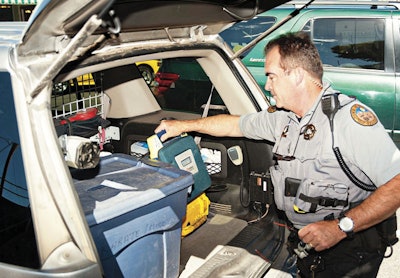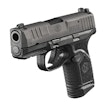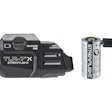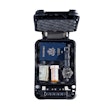 Photo courtesy of Gerard Zlotkowski.
Photo courtesy of Gerard Zlotkowski.
Every officer's career includes that moment where the world stopped. It murdered the rest of the innocence you may have had left in your heart before you got on this job. For some of our brethren in the Los Angeles Police Department that "moment" came on Feb. 28, 1997, during the North Hollywood Shootout.
More than 300 officers responded and more than 1,700 rounds were fired between the police and the heavily armed bank robbery suspects, as police pistols and shotguns proved to be no match for the bad guys' armor and full-auto assault weapons. The police won and the suspects lost. But the victory was costly, as both police and civilians were wounded in the battle. Once the smoke cleared, agencies nationwide started adding rifles to their arsenals and strengthening their tactical operations units.
Patrol Rifles
Even before North Hollywood, rifles were essential for rural officers. But not every rural agency permits its officers to carry them. If your department doesn't issue patrol rifles and doesn't allow you to carry your own personal rifles, a conversation with your superiors is in order.
This is not a conversation that you should have in the hallway heading out after roll call. Do it right. Back it up with research in writing and check with surrounding agencies on their policies. Write a position paper on the subject and send it up the proper chain of command.
Even after all of that work, you shouldn't expect miracles. But you should expect a response. A proper response doesn't include: "No. We are not doing it and don't ask again because that won't happen here." A proper response includes guidance that will help you make it happen.
Many large law enforcement agencies have a mix of issued weapons. Smaller agencies do not have to contend with as many specific variables. So it’s easier for them to tailor their arsenals to fit their needs.
Budgets being what they are, issued weapons are less common than they used to be for smaller agencies. But allowing officers to purchase their own rifles and have them checked by a department armorer to comply with department guidelines and standards is almost a no-cost option for a department. This sets standards while still maintaining consistency.
Smaller departments have smaller budgets, so creativity is a real necessity. But all that aside, there are some basics to think about when outfitting your department with advanced weapons.
Choosing a Rifle
Intermediate level weapons will suit most purposes. You have the advantage of high round capacity in the AR platform of rifles. And when you are a long way away from the nearest backup like most rural officers, a high round count is something to be desired. It can keep you in the fight longer and tip the odds in your favor.
Another great thing about the AR platform is that it is almost infinitely customizable to meet your needs. Manufacturers make so many accessories for the AR that you have every option for outfitting it under the sun. The AR is also well-suited for rural law enforcement because it works very as well as an animal control rifle from a distance.
At my agency we use select-fire weapons, and we operate and train in full-auto mode. Our preferred AR ammo is the 5.56mm NATO cartridge, specifically, the M193 round. But my advice is to test different brands and bullet weights at various distances to see what works best in your department or personal firearms. We swapped out all of the metal magazines as well, replacing them with Magpul PMags.[PAGEBREAK]To give ourselves maximum firepower, we joined two of the magazines together and they are loaded into the rifles this way. This gives us the ability to immediately bring 60 rounds to the fight when the rifle leaves the car. And it allows for rapid magazine changes without taking our eyes off the target, which can be very important in a fight.
Shotgun Options
My agency also permits Remington 870 shotguns in each vehicle and two others in our trunk-stored arsenal. One of the trunk guns is dedicated for less-lethal work, and the other is a short-barreled version for breaching.
We selected the Remington 870 PMAX shotgun for our patrol vehicles. It has a pistol grip with full shoulder stock and an extended magazine tube giving it six-plus-one capacity.
The best feature on our patrol shotguns is the flashlight dedicated forend. I also equipped mine with sidesaddles to carry six extra rounds on the left side of the receiver. All have three-point slings that also hold six extra rounds on the right side of the stock. So when that shotgun leaves the vehicle, there are 18 rounds coming to the fight, 12 buckshot and 6 slugs.
Our patrol shotguns are loaded with Federal buckshot in the vehicle weapons lock, and they are fitted with ghost ring rear sights and white dot front sights.
One of my 870s is designated for use with less-lethal munitions only. If you are going to introduce less-lethal impact round capability into your agency, develop a very specific policy that addresses how to mark the weapon and when it is to be used.
Shotguns designated for less-lethal applications in my agency are stored in a brightly colored case separate from all the other weapons. The ammunition is also stored separately from the lethal ammo. The guns themselves are fitted with a bright orange stock and forend. My less-lethal 870 also has a Burris Speed Bead sight. I recommend it for less-lethal shotguns or launchers. Accurate shots on target are every bit as important, if not more, for less-lethal shots on a person, since missing the intended target may result in severe injury where none can be justified.
17 Plus 1
My agency's standard sidearm is the Glock 22 in .40 S&W. We just transitioned to the Generation 4 model. We were carrying the Gen 3 model.
As far as accessories, we have weapon-mounted lights as standard issue. We also have laser sights, which are an excellent psychological intimidation tool. The laser dot can prevent a shooting if the bad guy sees where the round is going to hit.
When our sidearms are carried in their duty holsters, we add extended floorplates to our magazines. This bumps the capacity to 17 plus 1. We also carry two spare magazines on our duty belts.
Lots of Ammo
In our vehicles, there are bailout bags for active shooter scenarios. These bags have six loaded magazines for our rifles and six magazines for our sidearms. For the shotguns, there are 12 rounds of buckshot and 12 rounds of slugs.
In the driver's side door of each of our patrol vehicles, there are also multiple extra magazines for our sidearms. This is one reason why all of my agency's officers carry the same sidearm.
When your agency is considering switching sidearms, talk with your neighboring agencies and see what they carry. Ask questions and try out their guns. If every officer in the neighboring area carries the same make and caliber of pistol and can use each other's magazines, it might give the good guys the advantage in a prolonged fight.
It Can Happen Here
There are probably some of you reading who are wondering why my rural agency has invested in so much firepower. After all, we are not Chicago or Atlanta or Los Angeles, and our violent crime rate is actually pretty low.
There are a couple of reasons that this is a wise investment. One, active shooter incidents can happen anywhere, and they have. Two, people who live in rural areas tend to be better armed than most urban residents. So when we answer a domestic disturbance or some other seemingly routine call for service, we may be facing an angry, deranged, or intoxicated individual with a rifle. We need to be armed better than they are or at least equally so.
The officer who tells you, "mass shooting incidents can't happen out here in the country," is a fool and is dangerous. That officer's lack of tactical mindset could get him or her killed and probably a few other people too. This is especially true for those chiefs and other supervising officers who subscribe to this line of thinking.
After a mass shooting a chief or sheriff that didn't provide the necessary tools for his or her agency will face a lot of questions. Officers will want to know why. And the public will demand answers, too. If someone was killed, the lawsuits will fly.
I also think not providing your officers with the proper arsenal sends a terrible message to your subordinates that they are not trusted. They are already armed and trained to use firearms, right? A rifle or shotgun will deliver a round more accurately downrange. This, if anything, will swing the odds in favor of fewer rounds being fired, therefore ending the fight sooner and avoiding a drawn-out, protracted gunfight. And that's a good outcome.
It is our job to win the fight with the bad guys, whether we serve in the nation's most populated cities, smallest towns, or most isolated counties. To win that fight, we need the right firearms and the right ammo.
Gerard Zlotkowski is the chief deputy sheriff of McIntosh County, N.D. He has served in law enforcement, firefighting, and EMS since 1988 and can be reached at editor@policemag.com.
Related:












